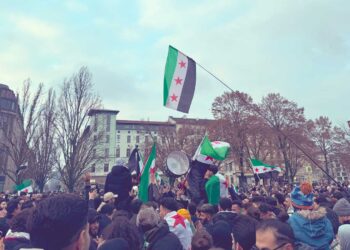Cities are a particular spatial form of producing and living space that relies on a whole set of political, social, economic, and juridical relations to be reproduced. Although they are shaped by ever-shifting relations, cities do reproduce entrenched patterns of displacement, dispossession, and class stratification, so that, for example, certain groups are more vulnerable to police violence, impoverishment, and other forms of organized abandonment. This is precisely the argument made by David Hugill in his book Settler Colonial City: Racism and Inequity in Postwar Minneapolis: contemporary urbanization in the United States relies on settler colonial patterns of dispossession and violence against the Indigenous communities, the collective owners of the land. There is much we can glean from Hugill’s book about other contexts where settler colonialism is a primary force, including Palestine.
The book is structured around the argument that the dispossession and elimination of Indigenous communities in what is now the United States is not a phenomenon relegated to the past. On the contrary, dispossession remains both active and constitutive; it is the background against which contemporary forms of racialized urbanization take place. The book focuses on the Minnesota’s Twin Cities of Minneapolis and St. Paul metropolitan region in the Upper Midwest in the aftermath of the Second World War. In the postwar conjuncture, suburbanization, urban renewal, and interstate construction transformed urban landscapes to maximize consumption and retain a façade of a flourishing economy. Concurrently, Indigenous communities became increasingly targeted with urban relocation programs that coerced them into more extreme levels of poverty, police violence, and deprivation. In other words, the aftermath of the Second World War set in motion a series of processes that pushed Indigenous communities out of reservations and into racialized urban environments. The Indigenous communities in Minnesota, especially the Dakota people, were no exception.
Although the 1934 Indian Reorganization Act (IRA) temporarily halted such state-sponsored territorial alienation, federal officials introduced new policies in 1945 that favoured assimilation and urban relocation, thus integrating reservation residents into the wage economy. Consequently, wartime relocations coalesced with such juridical and extra-legal forms of settler violence to ensure the territorial alienation of Indigenous communities as well as the continued discrimination against them in the Twin Cities. These settler colonials and capitalist factors meant that the Indigenous community in Minneapolis- St. Paul “mushroomed from only a few hundred people at the start of the war to more than 6,000 by the formal end of hostilities in Europe and the Pacific.” Following this population surge, Indigenous communities in the Twin Cities faced institutional and individual racism, particularly in the housing market, as narrated in chapters one and two of Hugill’s book.
The brutal reality here is that this process of relocation from the reservation to the urban centres was preceded by the destruction of Indigenous polity and a systemic theft of their lands. Hugill sketches a painful history of such Euro-American settler strategies of theft, which include treaties, systemic and direct violence, racism, and genocide. Treaties signed in 1851, which have been described as a ‘monstrous conspiracy,’ ensured the transfer of ownership of Indigenous lands into the hands of Euro-American settlers and the American state. Settler states use treaties and ‘peace accords’ to contain Indigenous demands for self-determination and advance their settler frontiers. As Glen Coulthard shows in his book Red Skin, White Masks, settler colonial states consistently rely on a ‘colonial politics of recognition’ to combat, contain, and annul Indigenous demands for self-determination. The ‘colonial politics of recognition’ do not only include State- and community-level treaties but also the intersubjective ways in which citizenship politics define the horizons of possibilities for Indigenous communities. Such colonial politics of recognition is especially true of Canada as a settler colonial state but can also be generalizable to other settler colonial contexts, including Palestine.
By reducing Palestinian self-determination to demands for a self-ruling neoliberal state within segments of the territories occupied in 1967 (the West Bank, the Gaza Strip, and East Jerusalem), the Oslo process effectively sedimented and intensified the segregation of Palestinian geographies. The Oslo Accords, which were signed between the Palestinian Liberation Organization and the Israeli settler state in 1994, serve as an apt example of this ‘colonial politics of recognition.’ The Accords reified the fragmentation of Palestinian geography and postponed the fate of Palestinian refugees to a future round of negotiations, excluded 1,9 million Palestinians living as citizens within the Green Line, relegated them to intersubjective and institutional modes of racism, and facilitated the besiegement of the Gaza Strip since 2006. The Accords, brokered by the US and guarded by its imperialist interests in the region, meant the nourishing of a parasitic, West Bank-based Palestinian nationalist elite that continue to seek economic ‘progress’ in light of an engulfing settler-colonial reality. The conundrum here is that this particular Palestinian nationalist iteration has become an enabler of both neoliberal capitalism and Israeli settler colonialism: it seeks to privatize Palestinian lands and properties, encourage consumerism, and create a façade of normalcy in a colonial context (an abnormal reality worthy of resistance by definition). Its project does not come in friction with the settler state but instead supports it; Israeli settlements have exponentially increased since the signing of the Accords and Palestinian communities continue to be territorially alienated and fragmented as a consequence. In some ways, Kareem Rabie’s book Palestine is Throwing a Party and the Whole World is Invited is suggestive when read alongside Hugill’s, for it also tries to take Ramallah as an entry point into showing how neoliberal capital feeds onto the patterned relations of dispossession that Israeli settler colonialism imposes on Palestine. While Ramallah expands as an urban fabric, Rabie reminds us that the rest of Palestine shrinks; urbanization is the result of this contradiction between capitalism and settler colonialism.
Under settler colonialism, juridical and economic violence are accompanied by brute, direct violence. The theft of Dakota lands, which was solidified through the 1851 treaties, would later trigger an important Indigenous Dakota revolt against the US in 1862. Hugill notes how this revolt “was met with a settler counterinsurgency program so comprehensive that it ended in what remains the largest mass execution in US history and the outright expulsion of Dakota people from their traditional territory.” He goes on to remind us that Dakota scholar Waziyatawin builds on the definitions outlined in the 1948 United Nations Convention on the Prevention and Punishment of the Crime of Genocide, arguing that the 1862 executions, followed by the forced displacement of Indigenous communities, constitute ‘acts of genocide.’ Such gruesome violence, which always accompanies forms of settler colonialism, facilitated the advancement of the settler frontier and the confinement of Indigenous communities into reservations. Indeed, by the end of the nineteenth century, “much of the arable land in the American West had been transferred to state and private lands.”
In its pursuit of land, settler colonialism insists on the elimination and dispossession of Indigenous communities through policies and practices that range from genocide to assimilation. Settler colonialism is a system of violence produced by a set of relations structured around a logic of elimination. It is no surprise that settler colonialism reverts to genocide to achieve its ends, and it is no surprise that the Israeli settler state, for example, continues to desperately call for its Euro-American allies to hide its tracks of genocide and violence across the land of historic Palestine. It should be very clear to students of history that the unfolding Israeli genocide in Gaza is a culmination of a settler colonial project that insists on dispossessing Palestinians from their lands. Although the unfolding genocide in Gaza is its most brutal manifestation, this settler colonial project still advances a plethora of juridical, economic, political, and social relations that target Palestinian presence. For example, it ghettoizes Palestinians and pushes them into spaces of poverty and socially engineered inter-communal violence in the cities it had occupied in 1948. Indeed, as Lana Tatour shows, the number of Palestinians killed in crime-related violence rose from 150 Palestinians between 1980 and 2000 to 1,236 Palestinians between 2000 and 2017. These numbers have only seen sharp increases since then. In 2023 alone, more than 244 Palestinians were killed in crime-related violence in the cities Israel had occupied in 1948. Those are the same Palestinians whose lands Israel had systematically stolen through gruesome violence, and then through the legal codification of that theft through institutions such as the Jewish National Fund, the Development Authority, and Amidar National Housing Company.
Hugill’s book, when stretched to the context of Palestine, helps us show how the racialization of the Palestinians today, and their vulnerability to different forms of direct and indirect violence, occurs against the backdrop of patterned relations of dispossession and displacement. I follow Ruth Wilson Gilmore’s definition of racialization here as “the state-sanctioned and/or legal production and exploitation of group-differentiated vulnerabilities to premature death, in distinct yet densely interconnected political geographies.” Importantly, chapter four highlights how the promotion of the Twin Cities as ‘progressive’ and wealthy havens has been at the cost of imperialist extraction and violence. Hugill shows how the life of the Philips neighbourhood, where an Indigenous majority came to be concentrated, is intimately linked to a broader economy of American state violence, particularly through the neighbourhood’s corporate resident the Honeywell Corporation. Through its development of destructive instruments and weapons, the corporation is directly complicit in overseas US imperialist violence. In responding to anti-war protestors, the corporation has sought to alleviate some of the unrest by extending social support programmes to Indigenous residents of the neighbourhood. Such actions epitomize the brutal manifestation of US capitalism and imperialism: to coercively make an impoverished community’s only choice to be reliant on a weapons manufacturer complicit in imperialist violence.
It is such material contradictions and links that prompt students and faculty at universities across Turtle Island to protest. They refuse to allow the intimate details of their livelihoods to be complicit in the genocide being perpetrated against the Palestinian people. And this is perhaps an apt ending: to remind ourselves that those links can and will be severed when faced with staunch protests and resistance.








